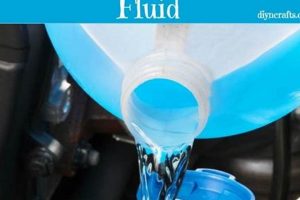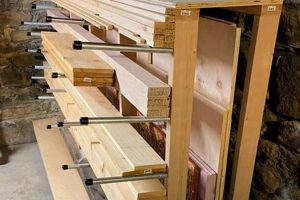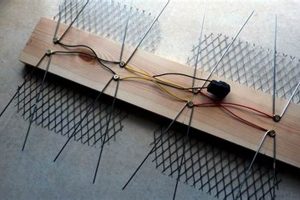Creating customized work surfaces for food preparation areas through the use of a self-applied cement mixture represents a growing trend in home renovation. The process involves combining cement, aggregate, and water, then pouring the mixture into molds or directly onto existing cabinets. This technique allows homeowners to achieve a unique aesthetic and tailor dimensions to specific spatial requirements.
The appeal lies in the potential for cost savings compared to professionally installed alternatives, as well as the opportunity for personalized design. Integral color pigments, decorative inlays, and unique edge profiles can be incorporated to achieve a specific visual effect. Historically, such construction methods were primarily confined to industrial or commercial settings, but increasing accessibility to information and materials has facilitated adoption in residential applications.
The subsequent sections will address the necessary materials and tools, outline the step-by-step procedure for successful fabrication, and explore essential sealing and maintenance practices for ensuring longevity and aesthetic appeal of the finished surface.
Essential Considerations for Cement-Based Kitchen Surfaces
The fabrication of cement-based kitchen surfaces necessitates careful planning and execution to achieve a durable and aesthetically pleasing result. Adherence to best practices significantly mitigates the risk of common failures, such as cracking, staining, and inadequate sealing.
Tip 1: Mold Integrity: The structural integrity of the mold is paramount. Reinforce forms with external bracing to prevent bowing or deformation during the pour. Any dimensional inconsistencies in the mold will be directly reflected in the finished surface.
Tip 2: Mixture Consistency: Maintain a consistent water-to-cement ratio throughout the mixing process. Excessive water weakens the cement matrix, increasing porosity and susceptibility to staining. A slump test is recommended to verify proper consistency.
Tip 3: Reinforcement Incorporation: Integrate steel or fiber reinforcement to enhance tensile strength and minimize cracking. Ensure adequate coverage of the reinforcement material within the cement matrix to maximize its effectiveness.
Tip 4: Vibration for Consolidation: Utilize a concrete vibrator to eliminate air pockets and consolidate the mixture. Over-vibration can cause segregation of the aggregate, leading to surface defects. Observe for the cessation of air bubble release as an indicator of adequate consolidation.
Tip 5: Curing Environment Control: Control the curing environment to prevent rapid moisture loss, which can result in cracking. Cover the surface with plastic sheeting or apply a curing compound to maintain humidity and promote proper hydration of the cement.
Tip 6: Strategic Joint Placement: Incorporate expansion joints into larger surfaces to accommodate thermal movement and reduce the risk of stress cracking. Consult structural engineering guidelines for appropriate joint spacing and design.
These considerations collectively contribute to the long-term performance and aesthetic appeal of cement-based kitchen surfaces, minimizing the potential for costly repairs or replacements. Prioritizing these aspects of the process is a crucial investment in the project’s overall success.
The subsequent section will explore methods for surface finishing and the selection of appropriate sealants to provide a durable and stain-resistant finish.
1. Mixture Proportions
The determination of mixture proportions represents a critical phase in the successful creation of cement-based kitchen work surfaces. The ratio of cement, aggregate, water, and any admixtures directly influences the material’s strength, workability, density, and resistance to cracking and staining. Inadequate proportioning can lead to structural weaknesses and aesthetic flaws that compromise the countertop’s longevity and functionality.
- Cement-to-Aggregate Ratio
The ratio of cement to aggregate significantly affects the strength and durability of the cement matrix. A higher cement content generally results in increased strength but can also increase the risk of shrinkage and cracking. A lower cement content may reduce strength and increase porosity. For example, a mix too heavy on aggregate may lead to a weaker, more brittle surface prone to chipping, whereas too much cement risks cracking and increased cost.
- Water-to-Cement Ratio
The water-to-cement ratio (w/c) is a primary determinant of the cement’s final strength and permeability. A lower w/c ratio typically yields a stronger, denser, and less permeable product, improving resistance to staining and abrasion. However, excessively low w/c ratios can make the mixture unworkable. An example includes using too much water. This could lead to a weaker mixture that is prone to cracking and water damage.
- Admixture Inclusion
Admixtures, such as plasticizers, superplasticizers, and air-entraining agents, can be incorporated to modify the properties of the wet and hardened concrete. Plasticizers improve workability without increasing the w/c ratio, while superplasticizers further enhance workability and allow for even lower w/c ratios. Air-entraining agents improve freeze-thaw resistance. For example, adding a pigment admixture for color needs careful calibration to avoid weakening the mix’s structural integrity.
- Aggregate Selection
The type and size of aggregate influence the workability, strength, and aesthetic appearance of the cement. Finer aggregates generally improve workability and surface finish, while coarser aggregates can increase strength and reduce shrinkage. Consider quartz for its durability and granite chips for their visual appeal and strength. Inappropriate aggregate sizes lead to uneven surfaces and weak structural performance.
In conclusion, the careful selection and proportioning of mixture components are paramount for achieving a durable, aesthetically pleasing, and functional surface when undertaking cement-based kitchen work surface projects. The examples and implications outlined underscore the necessity for meticulous planning and execution during the mixture design phase to mitigate potential failures and ensure long-term satisfaction.
2. Reinforcement Placement
The incorporation of reinforcement within cement-based kitchen work surfaces is a critical structural measure designed to mitigate the inherent tensile weakness of the material. Precise positioning and adequate coverage are essential to resist cracking and ensure long-term durability, particularly under the stresses associated with daily use. Improper reinforcement can render the countertop vulnerable to catastrophic failure.
-
Type of Reinforcement Material
The selection of reinforcement material significantly impacts the overall strength and performance. Welded wire mesh (WWM), rebar, and fiber reinforcement are common choices, each offering different characteristics in terms of tensile strength, corrosion resistance, and ease of use. WWM provides distributed reinforcement, while rebar offers concentrated strength in specific areas. Fiber reinforcement, such as fiberglass or polypropylene, can reduce shrinkage cracking and improve impact resistance. Using an inappropriate material could lead to corrosion or insufficient strength.
- Location Within the Countertop
Strategic placement of reinforcement within the cement matrix is crucial. Reinforcement should be positioned in areas subjected to the highest tensile stresses, typically near the bottom surface of the countertop where bending stresses are greatest. Adequate cover, the distance between the reinforcement and the surface, is also critical to prevent corrosion. Placing reinforcement too close to the surface increases the risk of spalling and corrosion, while insufficient coverage reduces its effectiveness.
- Overlap and Anchorage
Where reinforcement sections overlap, sufficient anchorage is necessary to ensure load transfer. Overlap lengths should adhere to established engineering guidelines to prevent slippage under stress. Additionally, reinforcement should be adequately anchored at edges and corners to prevent pullout. Insufficient overlap will negate the reinforcement’s effectiveness, allowing cracks to propagate through the material.
- Support Around Openings
Areas around sinks, cooktops, and other openings require additional reinforcement due to stress concentrations. Reinforcement should be carefully placed to distribute loads away from the opening and prevent cracking at corners. Neglecting reinforcement around such openings will lead to crack formation around the opening.
Effective reinforcement placement is indispensable for the structural integrity and longevity of cement-based kitchen work surfaces. The examples underscore the critical need for diligent planning and execution to ensure that the reinforcement effectively resists tensile forces, thus minimizing the risk of cracking and extending the lifespan of the countertop. Correct implementation, based on established building methods, is paramount.
3. Formwork Accuracy
Formwork accuracy is paramount in the creation of cement-based kitchen surfaces. The formwork serves as the mold that defines the countertop’s shape, dimensions, and edge profile. Any inaccuracies in the formwork will be directly replicated in the hardened cement, leading to dimensional errors, uneven surfaces, and aesthetic imperfections. For instance, if the formwork is not perfectly level, the resulting countertop will exhibit an uneven surface, rendering it unsuitable for level appliance placement and potentially affecting drainage.
Accurate formwork construction necessitates precise measurements, rigid materials, and secure assembly. The internal surfaces of the formwork must be smooth and free of imperfections to ensure a flawless surface finish on the cement. A real-world example involves using flexible or warped materials for formwork, which can lead to bowing or sagging during the pour, resulting in a countertop with inconsistent thickness and structural weaknesses. A poorly sealed form will allow cement slurry to leak, altering the mixture’s water-cement ratio at the surface and creating unsightly blemishes. The edges of the form define the profile of the countertop; any imperfections here translate directly into visible flaws.
Ultimately, accurate formwork significantly reduces the need for extensive grinding, patching, or rework after demolding, thereby minimizing material waste and labor. In scenarios where complex edge profiles or integrated features are desired, meticulous attention to formwork detail is crucial to achieving the intended design. Therefore, formwork accuracy represents a foundational element in the successful production of high-quality cement-based kitchen surfaces. The challenges associated with inaccurate formwork underscore the practical significance of investing time and resources in precise formwork construction.
4. Curing Process
The curing process is a critical stage in the production of durable and aesthetically pleasing cement-based kitchen work surfaces. It directly influences the hydration of cement particles, which determines the strength, density, and overall longevity of the finished product. Inadequate curing can lead to cracking, dusting, reduced strength, and increased permeability, ultimately compromising the countertop’s performance and lifespan.
- Moisture Retention
Maintaining adequate moisture levels is paramount during the curing phase. Cement hydration requires the continuous presence of water to facilitate the chemical reactions that bind the cement matrix. Rapid moisture loss can halt hydration prematurely, leading to incomplete bonding and weakened structure. Example: Covering the surface with plastic sheeting or applying a curing compound prevents excessive evaporation and promotes proper hydration, while failing to do so leads to surface cracking.
- Temperature Control
Temperature significantly affects the rate of cement hydration. Curing at excessively high temperatures can accelerate hydration, leading to rapid strength gain but also increasing the risk of cracking due to thermal stresses. Conversely, curing at low temperatures can slow down hydration, resulting in delayed strength development. Example: Maintaining a stable temperature range of 60-80F (15-27C) is ideal for cement hydration.
- Curing Duration
The duration of the curing period is directly related to the development of strength and durability. Prolonged curing allows for more complete hydration, resulting in a denser and stronger cement matrix. The recommended curing duration varies depending on the cement type, mixture proportions, and environmental conditions. Example: A curing period of at least 7 days is generally recommended for most cement-based kitchen work surfaces, with longer durations often beneficial for high-performance mixtures.
- Curing Methods
Various curing methods can be employed to maintain adequate moisture and temperature levels. These include water curing (ponding or spraying), covering with wet burlap, and application of curing compounds. The choice of method depends on factors such as the size and shape of the surface, environmental conditions, and cost considerations. Each method serves to retain moisture within the cement matrix, facilitating proper hydration and enhancing the cement’s structural integrity.
These facets of the curing process underscore the interconnectedness of hydration, temperature, duration, and method selection in achieving durable cement-based kitchen surfaces. Failure to properly manage any of these aspects can lead to substandard results, necessitating costly repairs or replacements. Attention to appropriate curing protocols is not merely a procedural step, but rather an investment in the long-term performance and aesthetic appeal of the finished product.
5. Sealing Selection
Proper sealing of self-applied cement kitchen surfaces represents a critical step in ensuring their long-term performance and aesthetic appeal. The porous nature of cement renders it susceptible to staining, water damage, and microbial growth. The selection of an appropriate sealant directly influences the countertop’s resistance to these factors, as well as its ease of maintenance and overall lifespan.
- Type of Sealer Chemistry
Various sealant chemistries exist, each offering distinct advantages and disadvantages. Acrylic sealers provide a cost-effective option with moderate stain resistance, while polyurethane sealers offer enhanced durability and chemical resistance. Epoxy sealers provide superior protection against harsh chemicals and abrasion but may require professional application. Penetrating sealers, such as silanes and siloxanes, impregnate the cement matrix to provide water repellency without altering the surface appearance. Example: Selecting an inappropriate sealer chemistry may lead to premature failure, staining, or incompatibility with cleaning products.
- Sealer Application Method
The method of sealer application significantly affects its effectiveness. Multiple thin coats generally provide better penetration and coverage than a single thick coat. Proper surface preparation, including cleaning and etching, is essential for optimal adhesion. The use of appropriate application tools, such as brushes, rollers, or sprayers, ensures uniform coverage. A hasty or careless application process can result in uneven coverage, trapped air bubbles, and compromised protection against stains and moisture. A poorly applied sealer allows liquids and contaminants to penetrate the porous cement, leading to staining, microbial growth, and structural degradation.
- Sealer Food Safety and VOC Content
For kitchen work surfaces, food safety is a paramount concern. Sealers intended for use in food preparation areas must be non-toxic and comply with relevant regulations regarding contact with food. Volatile organic compound (VOC) content is another important consideration, as high-VOC sealers can release harmful fumes during application and curing. Example: Choosing a sealer with a high VOC content may pose health risks to the individuals applying the sealer and to future inhabitants of the home.
- Sealer Maintenance Requirements
Different sealers require different maintenance procedures to maintain their protective properties. Some sealers may require periodic reapplication to maintain their stain resistance and water repellency. The use of appropriate cleaning products is also essential to avoid damaging the sealer or compromising its effectiveness. Over time, sealers wear down due to exposure to heat, chemicals, and abrasion, necessitating reapplication to restore the surface’s protective qualities.
The facets discussed are interconnected and critical in the context of do-it-yourself cement kitchen surfaces. Selecting the appropriate chemistry and ensuring proper application are essential for long-term durability, stain resistance, and safety. Considering food safety regulations and VOC content is of utmost importance for kitchen environments. Regularly maintaining the sealant layer is key to preserving the countertop’s original protection and aesthetic quality. These considerations collectively ensure that these cement surfaces are not only visually appealing but also functional and safe for food preparation.
6. Surface Finishing
Surface finishing directly dictates the aesthetic qualities and functional performance of self-applied cement kitchen surfaces. The techniques employed during this stage influence the countertop’s texture, smoothness, color consistency, and resistance to staining and abrasion, ultimately defining its overall character and usability within a kitchen environment.
- Grinding and Polishing
Grinding and polishing are subtractive processes used to achieve a smooth, uniform surface and expose the aggregate within the cement matrix. Grinding involves the use of progressively finer abrasive pads to remove surface imperfections and create a level plane. Polishing further refines the surface, enhancing its sheen and reflectivity. For example, coarse grinding may be necessary to remove formwork lines or blemishes, while fine polishing creates a glossy, easily cleanable surface. Improper grinding can lead to uneven surfaces or excessive aggregate exposure, detracting from the aesthetic appeal.
- Sealing and Coating Applications
Following grinding and polishing, sealers and coatings are applied to protect the cement from staining, water damage, and chemical attack. These materials penetrate the surface pores, creating a barrier against liquids and contaminants. Sealers can be applied in multiple layers to enhance their protective properties. For example, a penetrating sealer may be used to provide water repellency, followed by a topical coating to enhance stain resistance and provide a glossy finish. Inadequate sealing leaves the surface vulnerable to staining and degradation, requiring frequent cleaning and maintenance.
- Texturing and Detailing
Texturing techniques can be employed to create a variety of surface effects, ranging from subtle variations in texture to more pronounced patterns. Texturing can be achieved through methods such as stamping, troweling, or acid etching. Detailing involves the addition of decorative elements, such as inlays, aggregates, or pigments, to enhance the visual appeal. For example, adding glass chips or metal flakes to the cement mixture creates a unique, personalized design. Improper texturing can create uneven surfaces or areas that are difficult to clean, while poorly executed detailing can detract from the overall aesthetic.
- Coloring and Staining
Coloring and staining are used to alter the surface color of the cement. Integral pigments can be added to the cement mixture to create a uniform color throughout the material, while topical stains can be applied to create variegated or patterned effects. Color consistency is critical for achieving a visually appealing result. For example, using acid stains to create a marbled effect requires careful application and blending to avoid harsh lines or uneven color distribution. Inconsistent coloring can result in an unattractive and unprofessional appearance.
These four stages, all facets of surface finishing, work in concert to determine the quality and character of self-applied cement kitchen surfaces. They influence both the visual characteristics and functional performance of the finished product. Careful execution of each stage is essential for achieving a durable, aesthetically pleasing, and user-friendly countertop that enhances the overall kitchen environment.
Frequently Asked Questions
The following addresses common inquiries regarding the creation and maintenance of cement-based kitchen work surfaces. These questions aim to provide clarity on crucial aspects of the process.
Question 1: What is the expected lifespan of a cement-based kitchen work surface?
The lifespan varies depending on material quality, construction methods, and maintenance practices. Properly constructed and sealed surfaces can last for decades. However, neglect and improper sealing will reduce longevity.
Question 2: Is professional installation necessary, or can it be a do-it-yourself project?
While professional installation offers expertise and reduces the risk of errors, fabrication is possible. However, meticulous planning, accurate execution, and a thorough understanding of cement properties are essential for success.
Question 3: Are cement-based work surfaces susceptible to staining?
Untreated surfaces are indeed porous and prone to staining. Proper sealing with appropriate products is crucial to prevent staining from common kitchen spills such as oil, wine, and acidic substances.
Question 4: What are the primary advantages compared to granite or quartz?
Advantages include potential cost savings, design flexibility, and the ability to create custom shapes and sizes. The capacity for integral coloring and unique textural finishes is also a differentiating factor.
Question 5: What types of sealers are recommended for kitchen use?
Food-safe sealers with low or zero VOC content are recommended. Options include penetrating sealers, polyurethanes, and epoxies. The optimal choice depends on desired aesthetic, durability requirements, and budget.
Question 6: How is regular cleaning and maintenance performed?
Regular cleaning involves the use of mild, non-abrasive cleaners and soft cloths. Avoid harsh chemicals or abrasive scrubbers that can damage the sealer. Periodic resealing, typically every 1-3 years, is necessary to maintain stain resistance.
These answers provide a foundational understanding of cement-based kitchen work surfaces. Diligence in design, construction, and maintenance are paramount.
The subsequent section will delve into the environmental considerations associated with this construction method.
DIY Concrete Kitchen Countertops
This exploration has detailed the multifaceted nature of the fabrication and implementation of cement-based kitchen work surfaces. From initial mixture design to meticulous reinforcement placement, accurate formwork construction, and the critical curing and sealing processes, each step demands precision and informed decision-making. Considerations regarding material selection, food safety, and long-term maintenance underscore the commitment required to achieve a durable and aesthetically pleasing result. The inherent design flexibility offers a compelling alternative to conventional materials, provided that the outlined procedures are followed rigorously.
The viability of constructing cement kitchen surfaces rests upon a dedication to craftsmanship and a thorough understanding of cementitious materials. Homeowners and contractors must weigh the potential for cost savings and design customization against the demands of a labor-intensive and technically exacting process. Successful projects serve as durable testaments to thoughtful planning and diligent execution, but only through sustained awareness and careful maintenance can the longevity and value of these distinctive surfaces be assured.







